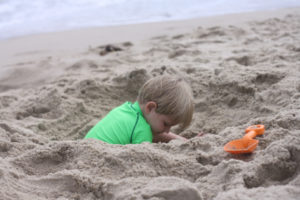
A father sprays his son’s back with sunscreen and releases him into the water at Newcomb Hollow Beach to play. It’s a common scene: an estimated 1.9 million people visit the Cape Cod National Seashore each summer between June and August and most tourists spend a good deal of their time in local waters.
The possible long-term effects of that sunscreen on the marine environment are worrying scientists. That’s because a 2016 study linked the death of coral in the U.S. Virgin Islands and Hawaii to exposure to oxybenzone, a common component of many chemical sunscreen products.
Craig Downs, executive director of the Haereticus Environmental Laboratory in Clifford, Va., was the lead author of that study.
“We were looking at Trunk Bay on Saint John, an iconic beach that gets about 6,000 people per day,” he told the Independent in a recent phone interview. “We couldn’t figure out what was killing the coral. There wasn’t anything obvious as an anthropogenic stressor, and we were trying to understand why it was dying at different rates in different bays.”
A local man overheard a conversation between Downs and another scientist in the grocery store.
“It’s the tourists’ sunscreen,” the man told them. “Go down to the beach at sunset and you can see the sheen.”
Forensic investigation by Downs’s team linked oxybenzone to four major toxic effects in young developing coral: increased susceptibility to bleaching, DNA damage, abnormal skeleton growth, and developmental deformities. In response to their findings vacation destinations including Hawaii, Key West, and the U.S. Virgin Islands have banned the sale of sunscreens containing oxybenzone and other chemicals, such as octinoxate, that are considered “contaminants of emerging concern.”
Downs and other scientists studying coral bleaching emphasize that the climate crisis is the most significant cause. But Downs’s research suggests that sunscreen can add to the problem in places where it is heavily used. Some sunscreens are marketed as “reef safe,” but the term is not regulated by the government and does not have an agreed-on definition.
Concern rises but there’s no local data
The effects of heavy sunscreen use on Outer Cape waters is unclear. Local organizations that study water quality and aquatic ecosystems express increasing concern about sunscreen, but there is hardly any research being done on the question here.
“In freshwater ponds there’s very, very little data,” said aquatic ecologist Sophia Fox of the Cape Cod National Seashore. “When we have heavy bather use in a small pond, what we need to know is what are the concentrations of the chemicals in these ponds in the middle of summer, and at what concentrations do things start happening? When we see a slick, does that actually contain the compounds we’re concerned about?”
Both Fox and fellow National Park Service researcher Stephen Smith said these are questions they are interested in. But they have been unable to pursue the answers with current staffing and budget levels. Inquiries to the Association to Preserve Cape Cod in Dennis, the Center for Coastal Studies in Provincetown, and the Cape Cod Cooperative Extension in Barnstable also failed to turn up any information on the effect of heavy sunscreen use on local aquatic ecosystems.
Wellfleet resident Gabrielle Griffis said she has been concerned about sunscreen pollution for several years and last year contacted state Sen. Julian Cyr’s office to suggest that Massachusetts consider a ban similar to the ones enacted in Hawaii and other U.S. jurisdictions. Cyr’s office said the idea was considered before this year’s session but that no legislation was filed.
Scientific American reported last year that the Center for Biological Diversity had petitioned the Food and Drug Administration to ban oxybenzone and octinoxate from sunscreen and personal-care products. U.S. Rep. Tulsi Gabbard of Hawaii, who is running for president, has said she plans to introduce federal legislation that would outlaw the sale of sunscreen with those compounds.
Chemical ultraviolet (UV) filters like oxybenzone are widely used in personal-care products as well as in food packaging, pharmaceuticals, and textiles. The chemicals reach waterways through both recreation and wastewater effluent, as they do not break down during the wastewater treatment process.
Oysters may be at risk
Two separate studies published this year in Science of the Total Environment detected the presence of UV filters in oysters along the northwest Portuguese coast and in Chesapeake Bay. These chemicals have been linked to reproductive toxicity and developmental disorders in a variety of marine organisms.
“This is a route of exposure that no one really talks about,” Downs said. “Polluted waters can reduce overall crop yields for farmed shellfish, edible algae, even fish.”
Downs said researchers are now studying the effects of these chemicals in aquatic ecosystems all over the world, from alpine lakes in Switzerland to trout rivers in Canada.
An infographic produced by the National Oceanic and Atmospheric Administration (NOAA) suggests balancing protecting ourselves and marine life by seeking shade between 10 a.m. and 2 p.m.; using protective clothing such as UV sunglasses, sun shirts, sun hats, and leggings; and choosing “sunscreens with chemicals that don’t harm marine life.”
Harmful ingredients listed on the graphic are oxybenzone, octinoxate, octocrylene, benzophenone-1, benzophenone-8, OD-PABA, 4-Methylbenzylidene camphor, 3-Benzylidene camphor, nano-Titanium dioxide, and nano-Zinc oxide. The alternatives are mineral sunscreens that rely on non-nano-Titanium dioxide and non-nano-Zinc oxide to prevent sunburn.
The town of Wellfleet installed free public sunscreen dispensers at Baker’s Field and Newcomb Hollow several years ago. But vandalism has been a problem, and the town has had to replace the units several times, according to Beach Administrator Suzanne Grout Thomas. She said Bright Guard sunscreen, which contains oxtinoxate, is provided by a foundation dedicated to melanoma prevention, started by the parents of a Barnstable lifeguard who died of the cancer in her 20s.
“The lifeguards are super diligent about sun protection,” Thomas said by email, “but they prefer sun protective clothing to chemicals.”
